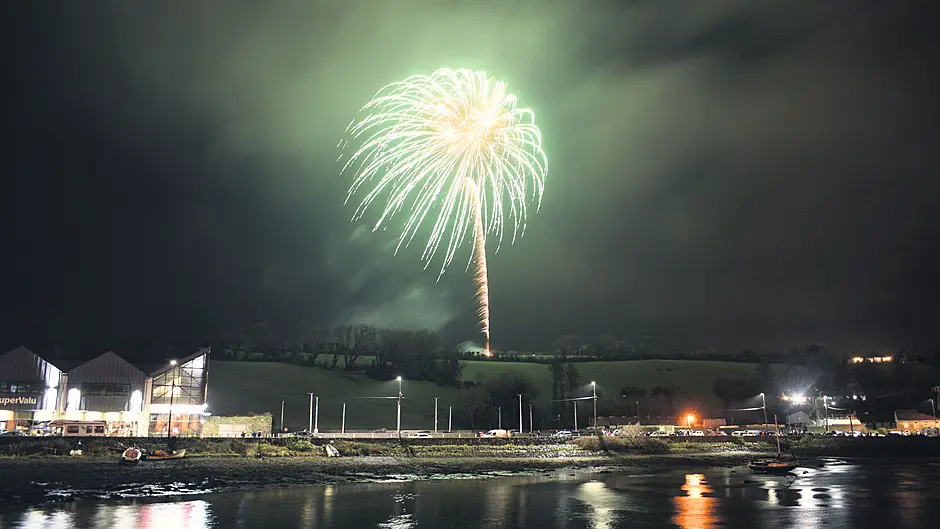From dancing to Dickie Rock at Enniskeane’s Lilac Ballroom, to parading through Courtmacsherry at midnight, staying in was never the preferred way to celebrate the New Year’s arrival around here!
EXACTLY 130 New Years ago, ‘the ringing of joy-bells’ pierced the cold night air in Kinsale, and brought life to ‘that dullness’ which follows Christmas. So said The Southern Star on January 14th 1893. However, in Clonakilty it was the ‘deep-toned’ funeral bell that drew most attention, as it tolled solemnly at eleven in the evening on December 31st 1900, to mark the death throes of the Old Year – and the ‘dying’ century (The Southern Star, January 5th 1901).
These ambivalent reactions encapsulate that strange mix of excitement and apprehension that many feel when the calendar changes and we take our annual leap into the unknown.
Time to reappraise, make New Year’s resolutions, plan those oft put-off life changes.
Memories of a new number chalked on the top right corner of the blackboard at school, a diary embossed in gold with a hitherto unseen numeral, and getting used to writing a new date on our cheques.
The New Year provides an evergreen excuse for festivity. But the ways of observing it have changed.
A recent (pre-Covid-19) survey revealed that 61% of Irish adults planned to ‘see it in’ at home.
Today, from the comfort of our own living room we can watch the celebrations around the world on our TVs and phones.
Our forebears would have frowned upon such spectator sports.
After opening the front and the back door, to let the new year in and the old one out, you headed for the square with other merrymakers, regardless of the weather.
‘The Skibbereen Silver Band played on the square – big crowds gathered and at midnight people sang and danced well into the night,’ said Brendan McCarthy of Skibbereen, recalling the early 80s in the West Cork town.
What a range of events you could choose between: gala buffets and suppers, ‘substantial teas’ and dinners, all-night dances and discos, community singing and showbands, parades and swims, street runs and trotting matches, hotel parties and minstrel shows, spot competitions and ‘monster’ whist drives.
One of the first festive functions recorded in The Southern Star was an all-male smoking concert, organised by the 1st Battalion Royal Inniskilling Fusiliers at Kinsale Barracks on New Year’s Night 1895. Servicemen and civilians enjoyed live music, ‘good songs and recitations’. Following a ‘very successful’ evening of dining, drinking, and, of course, smoking, the men linked arms at twelve o’clock to sing Auld Lang Syne and God Save the Queen, before exchanging New Year wishes. For over a century, Courtmacsherry has also seen in the New Year with razzmatazz. As midnight strikes, a group of magicians with banjos, guitars, accordions and tom-toms, still parade up Main Street to the pier head. At lunchtime, swimmers brave the elements at Broadstrand to raise money for the local lifeboat.
From across the harbour in Ringaskiddy and Carrigaline, residents will hear sea lovers in Cobh harbour sound their foghorns at midnight. The cathedral bells are rung, and a band marches through the town, playing old Irish tunes, followed by locals bashing tins. Candles once lit every window of every house, and passers-by might hear the thud of bread being beaten against doors to ward off starvation in the coming year.
By the late 1940s, New Year’s Eve meant jazz concerts; by the 1960s and 70s showbands were a must.
The dancefloor at Skibbereen Town Hall had limited capacity, explains 69-year-old John Leonard (born in Skibbereen and now living in Cork city), so the really big groups went to the Lilac Ballroom in Enniskeane. Thousands of revellers travelled to see them.
Hordes arrived by special buses, many others cycled to the gigs. He recalls ‘going there for Joe Dolan and the Drifters, and the Royal Showband with Brendan Bowyer. Other bands I remember were the Victors, Joe Mac and the Dixies, the Freshmen, Dickie Rock and the Miami.’
Today, even John tends to watch TV. ‘At midnight we look outside to see fireworks exploding everywhere – although they are illegal in Ireland!’ It’s a far cry from his childhood when people ventured out with tin whistles, mouth organs, bugles and hollowed-out cow horns. ‘Making noise rather than music was the objective,’ he recalls.
As we count down the seconds to another year, what lies ahead remains, as it always did, shrouded in mystery.
‘To anticipate what it may bring is impossible’, remarked The Southern Star in 1895.
Recent years have brought the horrors of pandemic and war, and we’ve been only too pleased to see the back of them.
In these uncertain times, let’s still hope that 2023 turns out to be a better one.
Happy New Year!










